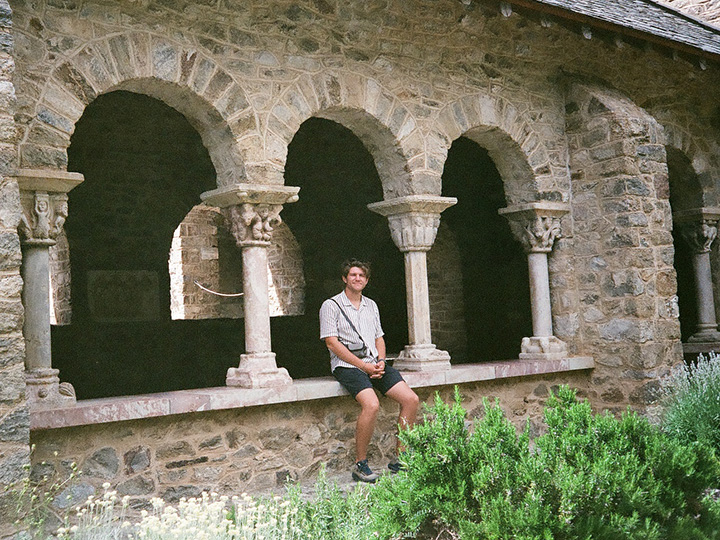
It’s an oft-repeated philosophy in the Creative Writing Program that the blending
of critical and creative approaches is generative for fiction writers, poets, and
scholars alike. Graduate student work often arises from fruitful interactions between
scholarly research and craft practice. FORWARD spoke with poet Marshall Woodward (MFA ’25), whose current book project—situated
at the intersection of poetics, politics, and history—exemplifies this blended approach.
Using docu-poetics, Woodward “explores Franco-American relations through one of New
York’s most terrific and troubling museums: The Met Cloisters.” This summer, Woodward
received a Cullen Travel Grant to travel to France and further his research.
FORWARD sat down with Woodward to hear more about his research at the French monasteries
from which the Met Cloisters draw their artifacts, and to discuss his study of medieval
manuscripts at the Rare Book School (funded by a scholarship from the Medieval Academy
of America).
This summer, you visited the original French sites of Manhattan's Met Cloisters, in
part to “investigate the colonization, indigenous expulsion and political whitewashing
associated with the site.” What did you learn about these hidden or obscured histories?
The two covered-over histories that I’m most interested in are, 1) that of the indigenous peoples of the island of Manhattan who were continually pushed north by, first, Dutch settlers, then British, then American settlers. The site that the Cloisters occupies now is not only the northernmost tip of the island, but also the highest. And so for that to be the last refuge and place that indigenous Americans inhabited in that geography—it’s pretty interesting to then have it remodeled as the pinnacle of French and Western civilization. It’s a weird look back to a medieval history that America doesn’t have. For John D. Rockefeller Jr., and the city and state of New York to choose this site to create a history that isn’t ours, and in turn erase the only one we actually have, is interesting. Through my poetry I’m trying to call attention to how odd that is, but also trying to find some inspiration: what is it we’re actually trying to reclaim? How have we changed—or not—over the hundred years since we built that temple to France?
The second: there’s this really long and weird tradition of the French turning old monasteries into prisons. Foucault writes a lot about this. Going back to one of the original monasteries, it became clear that the townspeople hated this place—because after the 1400s it became abandoned, and then in the 1800s turned into a prison, and after World War I turned into a children’s prison. It raises a lot of questions about the involuntary incarceration of prisoners, and the voluntary incarceration of monks.
The Cloisters become kind of a cool canvas to explore restitution, cultural heritage, patrimony, all those things.
How did the course in Paleography at the Rare Book School relate to your research in France?
Paleography is the study of the written word. In the Cloisters archive is something called the Cloisters Apocalypse, which is an illuminated manuscript of the Book of Revelation from 14th century France. It’s beautiful: gold inlaid, a very surreal depiction of the end of days. You have the Book of Revelation—which was written around 120 AD, depicted in 1330 AD—now being consumed in the 21st century, when the world is once again ending. One of the things I’m really interested in is that the world keeps ending—for different peoples, the world has ended many times. It relaxes our views of death and apocalypse to recognize that it’s a very human thing for the world to always be ending, which is how I got attracted to that manuscript. So I went to the Rare Book School to learn how to actually read that book: how to situate it with other books of revelation and apocalypse manuscripts from the time, and also hurling myself further into medieval academia. The whole week we were going through manuscripts from a 1200-year period to see how letter forms have changed, and how you can decide where and when a manuscript comes from based on the letter forms.
How did you get interested in this project?
The project itself started as a farewell letter to New York when I got into UH. Then,
taking the History of Poetics got me more into medieval stuff, and I’m applying for
a Fulbright to continue this research.
A poem by Marshall Woodward:
god’s plan.docx(3)
a monk, bored in a benedictine monastery
aloof to the demise of the mayans
transcribes another book of the apocalypse
his third this year
this codex for a norman,
who after a long summer of harvest
and siege, can steadily call himself king
no longer unready
and my monk, maybe an amleth (a louis?)
unafraid of divine vengeance, scribbles in the margins
a fool, armed with a bow, reaching from his anus.
his arrow flies
across calf’s skin, hits a devil in the eye
yes, he is erect. and my monk copies
the end of the world again
and again